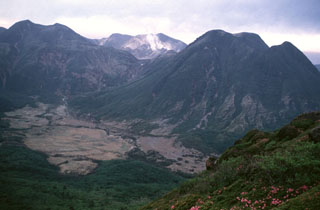Report on Kujusan (Japan) — January 1996
Bulletin of the Global Volcanism Network, vol. 21, no. 1 (January 1996)
Managing Editor: Richard Wunderman.
Kujusan (Japan) Earthquake swarm and eruptions on 13-14 January; continuous plume
Please cite this report as:
Global Volcanism Program, 1996. Report on Kujusan (Japan) (Wunderman, R., ed.). Bulletin of the Global Volcanism Network, 21:1. Smithsonian Institution. https://doi.org/10.5479/si.GVP.BGVN199601-282120
Kujusan
Japan
33.086°N, 131.249°E; summit elev. 1791 m
All times are local (unless otherwise noted)
Frequent earthquakes during the night of 13 January and through the next morning were centered 3-4 km NW of the Hosho dome near Sujiyu spa; eruptions caused minor ashfall around the volcano. Instruments recorded 526 earthquakes during the 13-14 January episode, some of which were felt by local residents. Some earthquakes on 27 January were centered SW of the active dome. Overall, there were 861 earthquakes detected in January, but no tremor. The plume height remained at 100-300 m throughout most of the month. Scientists at the University of Tokyo noted that vesiculated glass was again observed in the 13 January material, and deflation near the crater area was continuing.
Geological Summary. Kujusan is a complex of stratovolcanoes and lava domes lying NE of Aso caldera in north-central Kyushu. The group consists of 16 andesitic lava domes, five andesitic stratovolcanoes, and one basaltic cone. Activity dates back about 150,000 years. Six major andesitic-to-dacitic tephra deposits, many associated with the growth of lava domes, have been recorded during the Holocene. Eruptive activity has migrated systematically eastward during the past 5000 years. The latest magmatic activity occurred about 1600 years ago, when Kurodake lava dome at the E end of the complex was formed. The first reports of historical eruptions were in the 17th and 18th centuries, when phreatic or hydrothermal activity occurred. There are also many hot springs and hydrothermal fields. A fumarole on Hosho lava dome was the site of a sulfur mine for at least 500 years. Two geothermal power plants are in operation at Kuju.
Information Contacts: Volcanological Division, Seismological and Volcanological Department, Japan Meteorological Agency (JMA), 1-3-4 Ote-machi, Chiyoda-ku, Tokyo 100 Japan; Volcano Research Center, Earthquake Research Institute, University of Tokyo, Yayoi 1-1-1, Bunkyo-ku, Tokyo 113, Japan (URL: http://www.eri.u-tokyo.ac.jp/VRC/index_E.html).

